Pecos National Historical Park
A short distance east of the numerous art galleries in
modern Santa Fe, New Mexico, on the southern edge of the Sangre de
Christo mountains, prehistoric Native Americans constructed a large
pueblo on a ridge along Glorieta Creek, near the Pecos River confluence.
The park currently preserves several pueblos, the Spanish colonial
church, Spanish settlements, Santa Fe Trail sites, a section of the
Pecos River, and the Civil War battle sites at Glorieta Pass. Camping
is available in the Santa Fe National Forest, north of the park.

From the Visitor Center and Museum, a self-guided trail leads to
the ancient masonry pueblo and the historic adobe ruins of the
Spanish mission and convent. Interpretations on the trail and in
the museum, like at many southwest parks, are bilingual, in Spanish
and English.
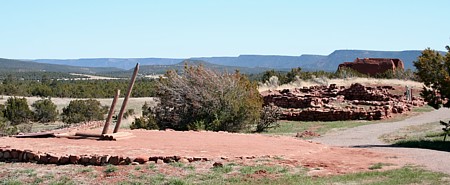
 |
Visitors can enter two reconstructed kivas along the trail.
One of the kivas is in the convent area.
Pecos was probably one of the largest
pueblos at European contact, when Coronado and his army of
1,200 arrived at then-called Cicuyé in
1540. A Plains Indian living at Pecos,
with tales of gold, lured Coronado's army
to the Great Plains hoping they would die. He was made to pay
for the ruse, sentenced to strangulation by Coronado.
About 60 years later, in 1598, Spaniards returned
to claim the territory of Nuevo Mexico for Crown and Church,
and to settle and built missions among the Puebloan Nations.
A friar was assigned to Pecos because of its size and its importance
in the Puebloan world. Initial relations included brutal attacks
on Native culture, justified as "idol smashing" by
the Colonial Spanish inquisitional midset. |
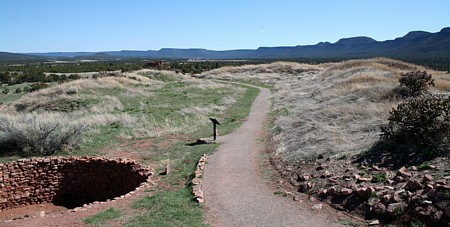
North Pueblo, the major prehistoric feature, enclosed several kivas.
A Spaniard in 1591 reported walls standing to five
stories high, households of 15 or 16 rooms, and neat and thoroughly
whitewashed buildings.
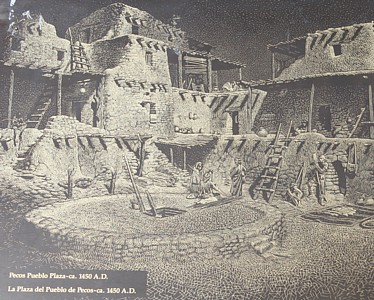
Artful interpertation plaques adorn the visitor trail.
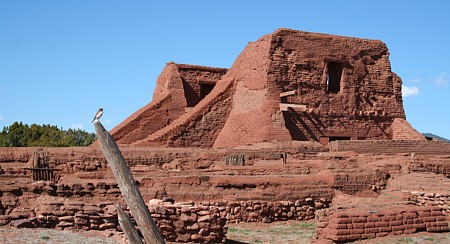
The church ruin standing today was the second church built at Cicuyé.
Both Spanish churches were built on the same spot. Only stone foundation
work of the first survives (below).
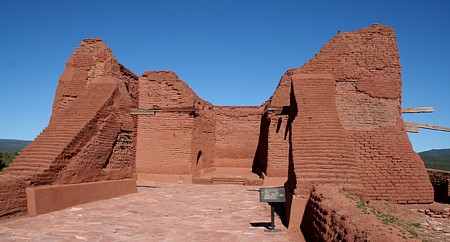
Franciscan Friar Andrés
Juárez arrived at Pecos in 1621 and directed construction of the
'Nuestra
Señora de los Angeles de Porciuncula de los Pecos' church,
the largest Spanish colonial structure north of the Mexican border.
The Natives destroyed the church during the 1680 Pueblo Revolt.
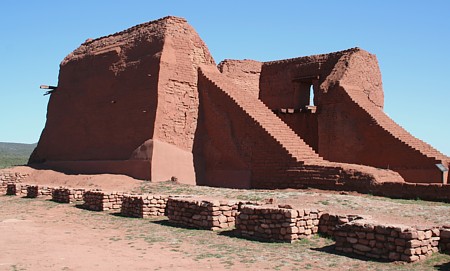

After decades of Spanish control, forced labor, tribute, injustice,
and repression, the Native populations cojoined in a regional revolt, the 1680 Pueblo Revolt,
forcing the Spanish to abandon the entire region north of modern-day
El Paso. Pecos inhabitants killed their priest, destroyed the
massive church, and constructed a once-foridden kiva in the convent
area.
The Spaniards returned with military force after 12 years. Tribute
was abolished as peace was imposed by the sword. The smaller,
rebuilt church was completed in 1717. Native populations
declined, primarily due to diseases—at Pecos from about 2,000
to 300. When the Santa Fe Trail arrived in 1821, a few survivors remained,
then, in 1838, moved to join other Towa-speakers at Jemez Pueblo.
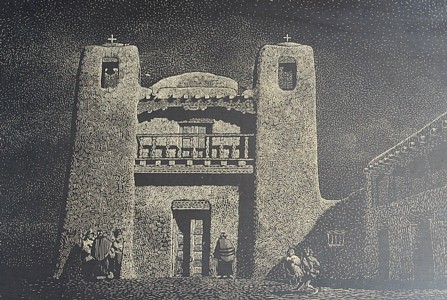
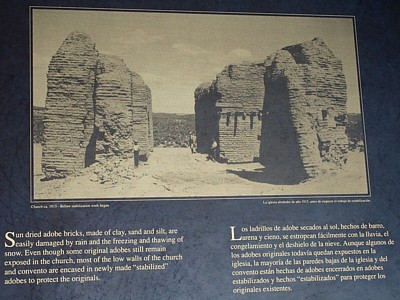
The clay, sand, and silt adobe bricks are susceptible to natural
forces. Considerable restoration encases most original colonial
walls. Even the restoration reveals different epoch of building and
variation in erosion. This early photograph illustrates the amount
of restoration/reconstruction.
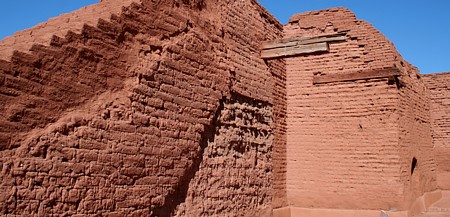
The museum displays the long chronology of the Native Americans, and
the recent Contact era, using artifacts and interpetations.

Archaeologist Albert Vincent Kidder brought the fledgling science of
archaeology to Pecos in 1915. Kidder tested the theory of stratigraphy
on the Pecos trash middens. After 12 field seasons, he had established
a relative chronology for the American Southwest based on ceramic
variation, in styles, materials, and techniques. At the 1927 Pecos
conference, he and other scientists established the classification
sytem still in use today, from Basketmaker to Puebloan periods. The
Pecos Conference tradition continues annually.
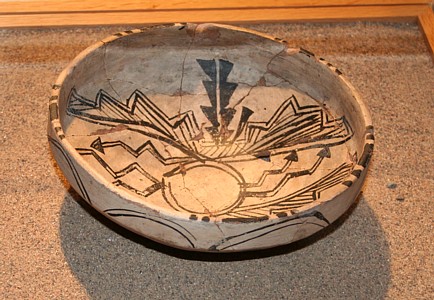
Early historic Tewa bowl with cloud and lightning symbols.
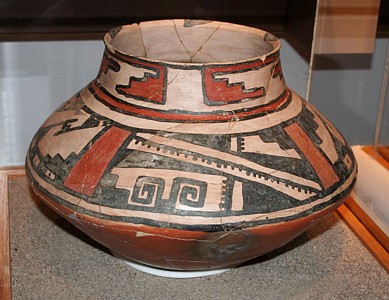
Glaze II/III jar.
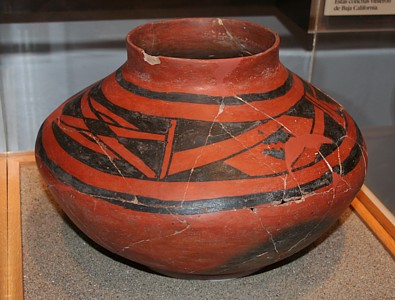
Glaze I red jar.

This bisque ware vessel from Pecos evidences trade/exchange with the
Rio Grande area.
![]()
![]()